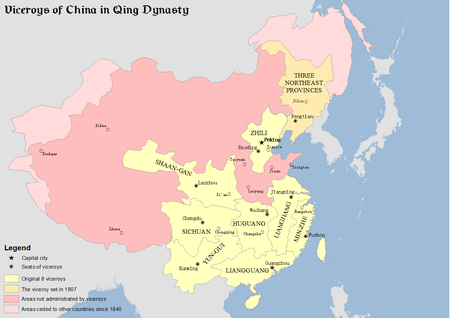Viceroys in China
Zongdu (Tsung-tu; simplified Chinese: 总督; traditional Chinese: 總督; pinyin: Zǒngdū; Wade–Giles: Tsung3-tu1; lit.: 'General Supervisor'; Manchu: ![]()


The title was first used use during the Ming dynasty (1368–1644).
One of the most important was the Viceroy of Zhili (Chihli), since it encompassed the imperial capital. Yuan Shikai, later President of Republican China, held this office.
Ming dynasty
During the Ming dynasty, the post of zongdu was originally an ad hoc appointment for military inspectors, especially along the northern border. As a temporary appointment, it had no fixed rank within the nine-rank system. It was during the Chenghua era, in 1469, that the Viceroy of Liangguang first became a regular appointment; subsequently the post gained civilian powers too, effectively uniting civil and military control in the provinces.
Qing dynasty
The Qing dynasty effectively inherited the late Ming system, wherein viceroys combined both military and civilian powers over one or more provinces. While the regularly-appointed Ming viceroys were concentrated on the northern border, against the military threat of the Mongols and Manchus, the Qing dynasty extended the system into China proper as well.
The regional viceroys, along with subordinate provinces, during the Qing dynasty were:
- Viceroy of Zhili
- Viceroy of Liangjiang: Jiangsu, Jiangxi, Anhui
- Viceroy of Min-Zhe: Fujian, Zhejiang, Taiwan
- Viceroy of Huguang: Hunan, Hubei
- Viceroy of Shaan-Gan: Shaanxi, Gansu, Xinjiang
- Viceroy of Liangguang: Guangdong, Guangxi
- Viceroy of Yun-Gui: Yunnan, Guizhou
- Viceroy of Sichuan
- Viceroy of the Three Northeast Provinces: Fengtian, Jilin, Heilongjiang
Chinese historians often rank the Viceroy of Zhili as the most honorable and powerful, and the Viceroy of Liangjiang as the richest of the eight. Certain provinces were not governed by any regional viceroys. These included the provinces of Shanxi, Shandong and Henan.
Besides the regional viceroys, there were also special types of viceroys, such as Viceroy of Southern Rivers and Viceroy of Eastern Rivers, who were in charge of waterways.
References
Further reading
- Mayers, William Frederick. The Chinese Government: A Manual of Chinese Titles, Categorically Arranged and Explained, with an Appendix. 3rd edition revised by G.M.H. Playfair ed. Shanghai: Kelly & Walsh, 1897; reprint, Taibei: Ch'eng-Wen Pub. Co., 1966.